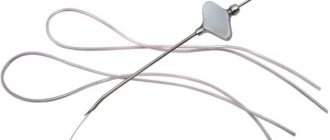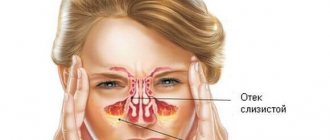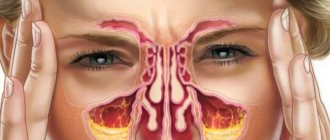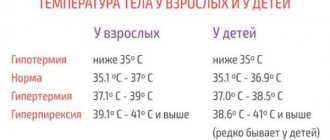Treatment of sinusitis with salt is a natural and safe method that complements drug therapy.
Salt allows you to:
- eliminate the causes of the disease,
- reduce swelling of the mucous membrane,
- improve drainage of the maxillary sinuses,
- prevent the spread of pathological microorganisms.
What salt to use
At the moment, there are many different salts available that can be used for medicinal purposes (table salt, iodized salt, sea salt, which in turn differs in the place of extraction).
The most effective treatment is sea salt, which contains a large number of beneficial microelements.
In addition to sodium chloride, these are:
- iron, which helps saturate cells with oxygen,
- iodine has an antimicrobial effect,
- magnesium and potassium improve cellular metabolism,
- zinc helps maintain the immune system,
- phosphorus is involved in the construction of cell membranes,
- manganese strengthens the immune system.
Of course, for treatment you can use table salt, which is more accessible, but it is worth remembering that it quickly loses all its beneficial properties (for example, the iodine contained disintegrates within a few days after the seal of the package is broken). If iodized table salt is placed in a dark glass container with a tight-fitting lid, the iodine retention period can increase to several weeks.
Treatment with salt occurs in combination with drug therapy.
Usually, rinsing the nasal sinuses with saline solution is prescribed, with further treatment with antiviral, antibacterial and anti-inflammatory drugs.
After completion of the acute stage of the disease, along with supportive drug therapy, visits to salt rooms can be prescribed to consolidate the result.
Sinus rinsing
Treatment of sinusitis with saline solution is widely used as home sinus rinses. Salt-based solutions help free the nasal sinuses from purulent contents, make breathing easier, and reduce the rate of spread of pathological flora.
To prepare solutions, you must use pure salt without dyes or flavors.
It is very simple to prepare a saline solution for washing the maxillary sinuses, using both sea and table salt.
Sea salt Table salt
| 1 tsp salts are dissolved in a liter of warm water until the salt crystals completely disappear | 1 tsp salt and 2-3 drops of iodine are dissolved in a liter of warm water until the salt crystals completely disappear |
| Washing is done twice a day (after waking up and before going to bed). The duration of the procedures is 7-10 days, after which a mandatory break is required. |
In addition to pure saline solution, herbal infusions in combination with salt can be used for rinsing.
To prepare such solutions use:
- pharmacy fees for sinusitis,
- individual dried herbs (chamomile, calendula, mint, eucalyptus).
Medicinal herbs are brewed and infused according to the instructions (usually 3 tsp of dried herbs per 200 ml of boiling water), add 0.5 tsp. salt per 0.5 liter of infusion. Infuse this solution for about an hour, after which the nasal passages are washed in the usual way.
Rinsing with a phyto-saline solution is carried out twice a day (in the morning and before bed) for a week, after which it is necessary to take a break and continue treatment if necessary and as recommended by an otolaryngologist.
It is recommended for sinusitis to rinse the nose with soda and salt with the addition of iodine. Due to its properties, this product can replace washing with sea salt.
To do this you need:
- 1 tsp salt, 1 tsp. soda, 6-8 drops of iodine, pour a liter of boiling water,
- cool the solution to a temperature of 36 degrees,
- The procedure is carried out twice a day for a week.
Salt rinses are suitable for both adults and children and have virtually no contraindications. It is worth considering that when preparing children's solutions for washing the maxillary sinuses, a lower concentration of active substances is used. You can use the recipe for adult solutions, which must be diluted with water (1 part solution to 2 parts boiled water).
With caution, you should use home rinsing of the maxillary sinuses with saline solution if you are predisposed to otitis media.
The video in this article clearly demonstrates all the stages of preparing a saline solution.
You can read more about the methods of rinsing the nasal sinuses, the solutions and techniques used for this, in the article “Rinsing the maxillary sinuses: recipes for home use.”
Saline dressings
Concentrated saline solution is an effective sorbent, and this property is used in the manufacture of saline dressings for sinusitis.
Application algorithm:
- To impregnate the dressings, a 10% solution is used (a lower concentration will not be effective), which is prepared by mixing water and salt at the rate of 10 grams of salt per 100 ml of water.
The water should be at a warm temperature (36-38 degrees), it is optimal to use boiled water.
- The bandage soaked in a strong saline solution is lightly wrung out and applied directly to the skin in the area of the nose and cheeks. To ensure better contact, cotton swabs can be placed on the wings of the nose over the bandage.
It is forbidden to put non-breathable material (polyethylene, rubber, etc.) on top of the bandage, as this will lead to skin burns.
- The bandage is fixed on top with a regular gauze bandage or a thin paper adhesive plaster.
- It is recommended to apply the bandage in the evening and keep it on overnight, but no more than 12 hours.
Salt dressings are used as prescribed by a doctor; the duration of the procedures can be from 7 to 14 days.
Precautionary measures:
- after removing the salt dressing, the used piece of fabric or gauze must be thrown away or washed and ironed,
- should not be used for skin diseases (acne, pimples), ulcers, cuts, wounds in the area where the bandage is applied,
- Use with caution in patients with heart and genitourinary diseases.
Inhalations
Salt-based steam inhalations are useful for reducing swelling as well as providing an antiseptic effect.
Instructions for preparing and performing salt inhalations:
- 2 tbsp. dissolve salt in 1 liter of water and boil the mixture for about five minutes,
- cool the solution to a temperature of 36-37 degrees,
- leaning over the container with the solution, you need to inhale the steam through your nose for 5 minutes (if the solution cools quickly, you can cover your head with a clean towel),
- After the procedure, it is necessary to avoid drafts and stay in cool rooms; it is optimal to go to bed immediately.
Usually salt inhalations are carried out 1-2 times a week. You can supplement and enhance the therapeutic effect by adding 5 drops of essential oil:
- eucalyptus,
- geraniums,
- pine trees,
- orange
Salt cave
A salt cave is a natural salt mine or a specially equipped chamber where all the walls are covered with salt. The cave has a special microclimate and is a very useful procedure for sinusitis, which is natural in its effects and safe for different age groups of patients.
The beneficial effect occurs due to the fact that the air has a high concentration of microelements that stimulate the body's protective functions. In order for beneficial substances to better penetrate the sinuses, an ionizer is turned on during the procedure.
As an auxiliary method, halotherapy (salt treatment in specially equipped caves, chambers, rooms) helps:
- clear the airways and remove mucus from the sinuses,
- increase immunity and develop resistance to respiratory diseases,
- reduce the need for inhalers and antimicrobials,
- reduce the dosage of medications and procedures, thereby reducing the risk of allergies,
- reduce the number of hospitalizations and relapses.
Rinsing the nasal sinuses with a solution of salt and soda
The most effective option for treating sinusitis is rinsing the nose with a concentrated infusion made from salt and soda. The product quickly removes purulent mucus, prevents the development of inflammation, and facilitates breathing.
In case of increased sensitivity, it is better to start procedures with a homemade weakly saturated medicine (reduce the amount of active ingredients by half).
If there are no side effects, gradually increase the amount of components to the desired proportions. Step-by-step folk recipe:
- Bring water to a boil, set to cool (you will need a glass of liquid).
- Pour salt and soda into warm water - 15 grams each.
- Mix the solution thoroughly; the salt crystals should completely dissolve.
Article for you:
How to properly treat papillomas with iodine
Rinse the nasal sinuses one by one with the prepared warm solution. Use a syringe, which will greatly facilitate the procedure. Repeat up to five times a day.
The solution can be stored in the refrigerator for no more than 24 hours. Before each use, it is recommended to warm the liquid - cold homemade medicine will provoke additional discomfort and painful sensations on the mucous membranes.
Is it possible to go to a salt cave with a runny nose? The benefits and harms of such procedures
Salt caves are artificial chambers with a special microclimate. Walls- The walls of these chambers are covered with salt, the evaporation of which has a positive effect on the body , which helps patients cope with a number of respiratory diseases, including a runny nose.
- This treatment is called 'halotherapy' and is indicated for patients of all ages.
Is it possible to visit a salt cave with a runny nose?
Such vapors in the form of an aerosol penetrate deep into the upper and lower respiratory tract, relieve swelling and help remove accumulated mucus .
If he has a runny nose, his symptoms may get worse when visiting these wards.
In general, this procedure has a whole range of positive therapeutic effects :
- Removal of inflammatory processes and swelling of the mucous membrane of the nasopharynx;
- bactericidal effect;
- removal of toxins produced during the disease;
- Activation of local and general immunity;
- Improving metabolism;
- Activation of cough reflexes, accelerating the removal of phlegm from the body
Doctors recommend this therapy several times a year, especially in childhood , when a person is most susceptible to colds.
Why might a runny nose appear after a salt cave?
- But it is a normal phenomenon due to the activation of the body's own defense systems .
- In this case, it can not only worsen a runny nose, but also cause additional symptoms (congestion in the nose, an increase in temperature to febrile levels, general malaise).
- The procedure should be continued and after the next 3-5 visits the patient's condition will begin to improve.
Recommendations for visiting the salt cave
When visiting these premises, you should consider some general recommendations and nuances:
- Halotherapy will be most effective for visiting caves during periods of incomplete remission.
- For the procedure you should use a Bahila, a blanket, a swimming cap .
Dress as you please, but it is important that your clothing does not restrict movement. This should also be taken into account, but dark clothing can leave difficult to remove salt marks that settle on the body. - You can visit such premises starting from , starting from one year. Such procedures are contraindicated in infants due to possible irritation of the mucous membranes under the influence of salt steam.
In some cases, such activities are allowed up to one year, but the child should not spend more than ten minutes in the salt cave. - In the salt room, it is important to observe your breathing: breathe calmly, deeply, evenly and relaxed. In this case, the maximum saturation of the lungs with air and the penetration of the largest number of salt particles into the blood. Accordingly, the therapeutic effect will be more pronounced.
- The number of visits to salt caves varies depending on a number of factors (age, general condition, severity of illness)
- You should consult your doctor before .
- If the runny nose is chronic, such courses should be carried out not only during an exacerbation of the disease, but also for preventive purposes (at least two additional courses per year).
Conclusion
From the above, the following conclusions can be drawn:
- Halotherapy Halotherapy is a safe physiotherapeutic procedure with virtually no contraindications.
- Patients should not have to decide for themselves whether they want to be treated in this way or not, let alone rely on this method as their primary method. Be sure to coordinate such meetings with your doctor .
Why might a runny nose appear after a salt cave?
In all patients, after the first visits to these premises, the symptoms of a runny nose begin to intensify.
But this is a normal phenomenon, which is explained by the activation of the body's defense systems .
In this case, not only the runny nose may worsen, but additional symptoms may also appear (nasal congestion, fever to febrile levels, general malaise).
Note! In children, such reactions to these procedures are more pronounced, but this is not a reason to refuse treatment.
The procedures should be continued, and after the next 3-5 visits the patient’s condition will begin to improve.
Treatment of a runny nose
The formation of unpleasant nasal mucus that interferes with breathing is a very common condition.
Many people do not consider this problem to be serious, and it is completely useless - it can negatively affect a person’s overall well-being and lead to a number of unpleasant consequences.
The human respiratory and vascular systems are interconnected, so treatment must be comprehensive, necessarily determining the root cause.
There is also a positive aspect of a cold or infection that occurs when a person has a runny nose, clearing the sinuses of mucus that accumulates there when a person is sick. The more mucus, the more toxins from our body. We invite everyone to our salt cave to improve their health and the health of their children.
Causes of runny nose
Is it possible to visit a salt cave if children and adults have a runny nose?
The deterioration is accompanied by loss of smell and difficulty breathing, which not only interferes with leading a normal life during the day, but also does not allow complete rest at night, which disrupts sleep. The deterioration is caused by a slight increase in body temperature and rapid fatigue.
Halotherapy sessions relieve these unpleasant symptoms. Microparticles of sodium chloride present in the air inhaled by patients during the procedure have an antiallergic and bactericidal effect.
They effectively fight pathogenic microbes and promote deep cleaning of the respiratory tract.
When visiting a salt cave, there is a rapid improvement in the mucous membranes, periods of free breathing become longer with each operation, the patient stops using sprays and drops that facilitate nasal breathing. The general condition improves and upon completion of the prescribed treatment, the normal condition is completely restored.
Floating air saturated with dry aerosol in a salt room:
- promotes rapid removal of allergens and toxins from the body;
- activates the mucous system (MSS);
- improves general metabolic processes;
- increases immunity and resistance to infections;
- has a strong bactericidal and anti-inflammatory effect
Contraindications
Steam inhalation is not recommended in the following cases:
- purulent inflammation;
- acute form of sinusitis, if the patient has elevated body temperature and feels unwell;
- the presence of a cyst in the sinus;
- diseases of the cardiovascular system;
- individual intolerance to the components of the product on the basis of which the inhalation solution is made.
Before starting inhalations for sinusitis at home, you should consult with an otolaryngologist.
How a salt cave helps get rid of sinusitis
HOW A SALT CAVE HELPS TO GET RID OF SINUSITIS.
The effectiveness of visiting a salt cave for sinusitis is due to the uniqueness of the constant concentration of salt microparticles in the air that actively stimulates the protective properties of the respiratory system and improves its drainage function. As a result, mucus is cleared from the maxillary sinuses, the epithelium of the maxillary sinus is restored and healthy breathing is normalized.
The drugs used often have side effects and allergic effects, so special attention should be paid to non-drug treatment methods such as halotherapy (salt treatment). Salt Cave is a clinically proven, natural, safe treatment for various age groups: Children, adults and seniors.
Visiting a salt room for sinusitis can significantly: - reduce the number of hospital stays - reduce the need for inhalers and antibiotics - clear mucus from the sinuses - increase resistance to respiratory diseases - strengthen the immune system
- improve overall well-being
Most people develop sinusitis after having the flu or a cold.
Heimoritis is an inflammatory process located in the paranatal sinuses, maxillary sinuses. The caterpillar sinus has common walls with the eye socket and the oral cavity, and is also anatomically connected with the nasal cavity.
Thus, the presence of foci of chronic infection in the mouth or nasopharynx may contribute to the development of sinusitis.
Staying in the hypobacterial environment of a salt room in case of sinusitis has a beneficial effect on the properties of the mucous membranes, reducing their swelling and activating the drainage of contents from the sinuses.
We would like to note that not a single visit will lead to a positive result. To achieve a therapeutic effect, it is necessary to complete a course consisting of 10-20 procedures over 40 minutes, but only after eliminating the symptoms of acute inflammation. To achieve a long-term therapeutic effect, it is necessary to repeat the preventive course.
Our salt cave in Salmeda has a halogen generator AGG-03, which creates a healing microclimate in the salt caves. Surfaces coated with natural salt help maintain temperature, humidity and hypobacterial conditions due to interaction with salt fog.
What are the benefits of salt caves for children?
It will not be possible to achieve a pronounced positive effect for the adenoids in 1–2 visits to a natural or artificially created cave with salt. To do this, you need to complete the full course - at least 8-10 procedures, 45-60 minutes each.
Against the background of inhaling air streams saturated with ions of sodium and magnesium salts, it is possible to achieve excellent results:
- not only local, but also general immunity is significantly increased;
- due to the suppression of the activity of pathogenic microflora and allergens in the child’s body, the concentration of unfavorable complexes that provoke inflammatory processes decreases;
- the nervous structures of the children’s brain get the opportunity to calm down - after a course of speleotherapy, children’s levels of aggressiveness and anxiety noticeably change, and their concentration improves;
- There is a clearing of the respiratory structures as a whole from pathological foci of microorganisms.
You should not think that an otolaryngologist recommends visiting such caves because he does not know how else to help a child with adenoids. This is only an additional technique to what was previously prescribed, for example, inhalations for adenoids or the use of the homeopathic remedy Lymphomyosot.
Sinusitis
Sinusitis Sinusitis is an inflammatory process located in the paranatal sinuses, maxillary sinuses. The disease can be unilateral or bilateral and can cause acute and chronic sinusitis due to the nature of the disease.
The caterpillar sinus has common walls with the orbit and oral cavity, and is also anatomically connected with the nasal cavity. Therefore, the presence of foci of chronic infection in the mouth or nasopharynx can contribute to the development of sinusitis.
Causes and symptoms of sinusitis
The main role in the development of the maxillary sinus is played by infection, which enters the maxillary sinus from the nose, mouth or through the blood circulation. The disease often develops against the background of a decrease in the body’s immunological response after viral or infectious diseases. The following factors contribute to the development of sinusitis:
- premature treatment of colds or viral respiratory diseases;
- anatomical features of the respiratory system (septal deformation, chronic hypertrophic rhinitis, adenoids)
- Decreased immunity due to prolonged general diseases, parasitosis;
- The presence of foci of chronic infection in the body (tonsillitis, caries and their complications, especially in the area of the upper chewing teeth)
Symptoms depend on the process. In acute sinusitis, there is a feeling of tension and disintegration in the area of the maxillary sinus, nasal discharge on the affected side (in a unilateral process), and nasal breathing is impaired.
The painful sensations intensify during the day and with the addition of purulent microflora, severe headaches of a funeral nature appear. The general condition worsens, body temperature rises to 38 degrees and above. Chronic sinusitis is characterized by less severe symptoms.
Methods for diagnosing and treating sinusitis
Diagnostics consists of comparing survey and survey data with subsequent refinement of the studies. X-ray of the perinal sinuses is an accessible and simple method for confirming the diagnosis of sinusitis. In this case, the x-ray image shows an area of shading corresponding to an inflammatory process in the sinus cavity.
Treatment includes a number of measures to ensure drainage of sinus contents and suppress infection. Antibiotic therapy is prescribed, in some cases it is indicated that the sinus is washed with antiseptic solutions. A visit to salt rooms for sinusitis is recommended after the symptoms of acute inflammation have subsided, in order to disinfect the chronic course and prevent exacerbations.
Halotherapy in the treatment of sinusitis
The effectiveness of Halotherapy for sinusitis is due to the unique properties of the artificial microclimate of salt caves. The constant concentration of salt microparticles in the air actively stimulates the protective properties of the respiratory system and improves drainage function.
Staying in the hypobacterial environment of the halochamber during sinusitis has a beneficial effect on the properties of the mucous membranes, reduces their swelling and activates the outflow of contents from the paranatal sinuses.
In case of sinusitis, it is recommended to visit the salt cave for 10-15 procedures, but only after eliminating the symptoms of acute inflammation.
To achieve a sustainable healing effect, it is necessary to repeat the preventive course every six months.
Before visiting the salt cave, it is recommended to consult with your doctor!
Salt cave for sinusitis: 6 main rules of halotherapy
The prescribed treatment is usually comprehensive, including medication and physical therapy. Complementary methods help speed recovery and are also important for people who experience multiple adverse reactions when taking medications.
Salt caves have long been known for their healing properties for diseases of the upper respiratory tract. Salt lamps, artificially created salt rooms, are used to create a therapeutic ionized microclimate, which is needed for the prevention and treatment of diseases of the respiratory system. It is also effective to visit salt caves for sinusitis.
What are salt caves?
Back in Ancient Greece, salt caves were popular for treating diseases and strengthening the immune system. People visited natural healing rooms and noticed positive effects: they got sick less and were always in a good mood.
The secret of the healing effect of caves is in the properties of natural salt. In rooms filled with salt, a natural chemical reaction occurs, during which, when salt interacts with air, sodium chloride ions are separated, creating a special microclimate.
A man in a salt cave inhales ionized air. This ensures cleansing and restoration of the respiratory tract, and overall strengthening of the body.
Halotherapy for sinusitis
One of the additional treatment methods for inflammation of the maxillary sinuses is halotherapy. The goal of treating sinusitis is to relieve inflammation and cleanse the maxillary sinuses of mucus and pus. A visit to a halochamber or salt room has a beneficial effect on the nasal mucosa, increases the outflow of mucous contents and gently cleanses the respiratory tract.
Halotherapy is treatment with sodium chloride ions, which the patient inhales while in a room with healing air. The halotherapy process only involves inhaling healing air with ions of magnesium, sodium, potassium, and iodine.
For such procedures, specialized rooms are built in which natural minerals of table salt are placed.
A hypobacterial environment with sodium chloride ions is achieved in a natural way; in addition, sodium chloride is sprayed in the halochamber in the form of an aerosol.
Inhaled salt air acts directly on the mucous membrane of the respiratory tract. The patient experiences improvement after just one course of halotherapeutic procedures.
Ionized air reduces swelling of the mucous membrane of the affected sinuses, thick mucus thins and begins to exit through the natural opening into the middle nasal passage.
After repeated procedures, the maxillary sinuses are cleared, after which the mucous membrane begins to recover. In a salt cave, the effect occurs not only on the nasal cavity and its paranasal sinuses, but also on the entire respiratory system.
Thanks to this, the body is actively saturated with oxygen, immune strength is increased and the general condition improves.
To relieve acute inflammation during sinusitis, the doctor prescribes a course of 20 procedures of 30 minutes each. For preventive purposes, it is advisable to visit the salt cave twice a year.
Recommendations for halotherapy
Who is recommended to conduct sessions in a salt cave?
- People with frequently recurring colds, rhinitis, sinusitis. If a patient with the initial stage is placed in a halochamber, after several procedures the inflammatory process will stop developing.
- Salt air will boost immunity and relieve allergies.
- A course of halotherapy is an additional method of treating sinusitis in the absence of contraindications.
- The healing microclimate of the chamber is filled with magnesium and potassium salts, so it is useful to spend time in the salt cave for people with a weakened nervous system, disorders of the cardiovascular system and to strengthen the immune system.
- Preventive courses to protect against inflammatory diseases of the respiratory system at any age.
Features of using a salt chamber
Before visiting a halo chamber or salt cave for the first time, the following conditions must be excluded:
- bronchial pathology in the acute stage;
- pulmonary tuberculosis;
- feverish condition;
- poisoning of the body.
If there are no contraindications, you can go to the salt room for recovery. Natural salt caves in Russia exist only in the Perm region, so sessions are held in an artificially created environment.
After the first sessions, cleansing mechanisms begin to start. This may cause a cough. This is a normal condition; cough occurs due to the discharge of stagnant mucus in the bronchi.
After half of the procedures completed, the cough syndrome decreases or disappears. If the cough continues to worsen and the general condition worsens, you must stop the sessions and consult a doctor.
Already at the first visit, an increase in temperature and the appearance of rhinitis are possible. All these are manifestations of cleansing the body of harmful and toxic substances.
Session rules
For maximum effect when in a cave, you need the following.
- Do not use decorative cosmetics.
- Physical activity must be stopped 1 hour before the session.
- During the procedure you need to wear clothing made from artificial fibers.
- It is not advisable to rub your eyes with your hands.
- After finishing, it is advisable to drink clean water for half an hour.
- There is no need to sleep during the session. During sleep, breathing becomes less deep and the healing effect will be less.
Reviews about halotherapy
Marina, 24 years old, Kazan.
“I used to have chronic rhinitis. What kind of tools have I not used? I was tormented by constant drops, without which it was difficult to breathe. At one point I developed sinusitis. I immediately went to the doctor.
The otorhinolaryngologist prescribed me a course of halotherapy in the salt room as my main treatment. After the first visits, I developed a severe cough and literally greenish contents poured out of my nose. I was afraid that something was wrong with me. The doctor said that this is how it should be.
I completed all the treatment and feel good. I will go to the salt room regularly for prevention.”
Alexandra, 32 years old, Moscow.
“We went to the salt room with our son. He was often sick, and the pediatrician told him to walk around and breathe in the healing air. How easy it was to breathe in the salt room! My son developed a slight runny nose and cough. I thought he was sick again and I was upset. The doctor said that this is normal. We walked for 20 days. My son really liked it, and I just had more vitality! I recommend to everyone!"
Article rating:
Loading…
Source: https://gaimorit.guru/procedures/solyanaya-peshhera-pri-gajmorite
The essence of the procedure
Salt caves are very beneficial for the body. In these places, humidity, pressure, temperature and oxygen composition are perfectly balanced. Here adults and children can get healthy and improve their overall health during illness.
If parents cannot send their child to a real salt cave, then they are offered a visit to a special room in which a similar microclimate is simulated.
The best time to stay is half an hour
The treatment procedure always follows the same pattern. It consists of several successive stages:
- The patient is taken into the room. As a rule, calm music plays in this place and the lights are dim.
- The child or adult is comfortably placed on a chaise lounge.
- Now the patient’s main task is to try to fully relax.
The human body quickly adapts to unfamiliar air. Because of this, internal organs have to change their work to adapt to new conditions.
It is necessary to calmly inhale healing air, which helps to cope with inflammatory processes due to overgrown adenoids. Along with this, the immune system, which was in a weakened state, is activated.
Each session takes about 40 minutes. Although children are usually in the salt cave for no longer than 30 minutes. This is the optimal time to achieve the desired effect from inhaling air saturated with beneficial microelements.







